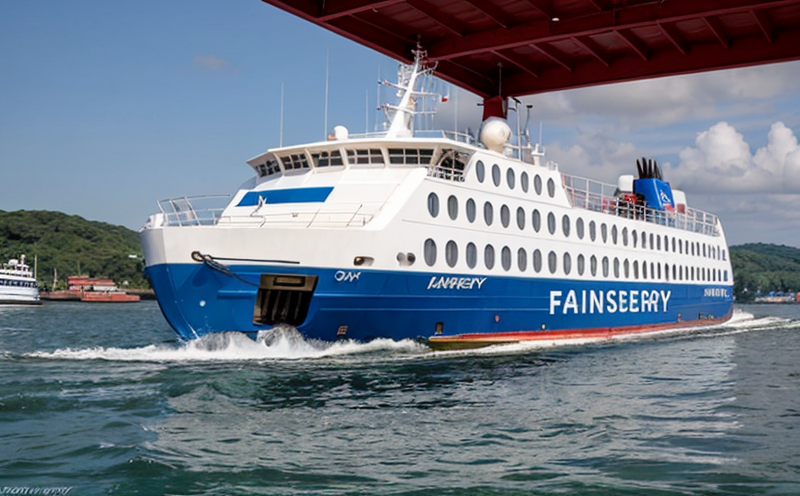Passenger ferry inspection
The process of inspecting passenger ferries is a critical component in ensuring maritime safety and compliance with international standards. This inspection ensures that all systems on board, including but not limited to hull integrity, machinery, electrical systems, and navigation equipment, are functioning correctly and meet regulatory requirements.
Passenger ferry inspections typically follow the guidelines set forth by organizations such as the International Maritime Organization (IMO), American Bureau of Shipping (ABS), Lloyd's Register (LR), and others. These standards are designed to ensure that ferries can operate safely in various environmental conditions, including rough seas and harsh weather.
The inspection process is comprehensive and includes a thorough examination of the ferry’s hull, deck, superstructure, propulsion systems, electrical equipment, fire safety systems, life-saving appliances, and more. The aim is not only to identify any existing issues but also to prevent potential hazards that could arise during operation.
During an inspection, various tests are conducted to ensure the integrity of the ferry’s structure and performance. These can include hydrostatic testing, vibration analysis, stress-strain analysis, and visual inspections. The results of these tests are documented meticulously and form part of the overall report submitted to relevant authorities.
The importance of passenger ferry inspection cannot be overstated. It plays a crucial role in maintaining public confidence in maritime transport and ensuring that all passengers travel safely. Regular inspections help identify potential failures early, allowing for timely repairs before they become critical issues.
By adhering to these stringent inspection protocols, operators can ensure their vessels comply with international regulations and best practices, thereby enhancing safety standards across the industry. This approach not only protects the lives of those who travel by ferry but also contributes significantly to environmental sustainability by minimizing fuel consumption and emissions through efficient operation.
Industry Applications
| Type of Inspection | Description | Purpose |
|---|---|---|
| Initial Inspection | This inspection is conducted before the ferry begins its service. It checks the overall condition of the vessel and ensures it meets all safety requirements. | To confirm that the vessel is fit for purpose and safe to operate. |
| Periodic Inspections | These inspections are carried out at regular intervals throughout the ferry's operational life. They focus on specific components that may degrade over time, such as engines or electrical systems. | To maintain and preserve the integrity of critical components to ensure continuous safe operation. |
| Ad-hoc Inspections | Carried out when there is an unexpected issue, such as a mechanical breakdown or damage sustained during an incident at sea. This inspection aims to diagnose and rectify the problem promptly. | To quickly address any issues that may pose immediate safety risks. |
| Environmental Impact Assessments | Description | Purpose |
|---|---|---|
| Hull Integrity Assessment | This involves checking the structural integrity of the hull, which is crucial for maintaining buoyancy and stability. | To ensure that the vessel remains seaworthy under various conditions. |
| Propulsion System Evaluation | Evaluates the efficiency and reliability of the propulsion system to reduce fuel consumption and emissions. | To minimize environmental impact by optimizing energy use. |
| Battery Performance Testing | This assesses the performance of batteries used for auxiliary power or emergency systems, ensuring they are reliable during critical times. | To enhance safety by providing a reliable source of power when needed most. |
Why Choose This Test
- Enhanced Safety: Ensures that all systems on board are functioning correctly, reducing the risk of accidents and incidents.
- Compliance Assurance: Helps operators meet regulatory requirements and international standards for maritime safety.
- Extended Vessel Lifespan: Regular inspections can identify potential problems early, allowing timely repairs that extend the service life of the vessel.
- Improved Efficiency: By maintaining optimal performance levels, inspections contribute to more efficient operations and reduced downtime.
- Environmental Impact Reduction: Through optimized energy use and emissions reduction measures identified during inspections, this process helps protect the environment.
- Certification and Reputation: Meeting rigorous inspection standards can enhance an operator's reputation for safety and reliability in the industry.
- Passenger Confidence: Ensuring high safety standards reassures passengers about their journey, leading to increased customer satisfaction and loyalty.
- Rigorous Standards Compliance: Passenger ferry inspections adhere strictly to international maritime safety regulations like those provided by the IMO, ABS, LR, etc., ensuring comprehensive coverage of all relevant requirements.
- Expertise and Experience: Our team comprises highly qualified professionals with extensive experience in maritime inspections, providing accurate and reliable results.
- State-of-the-Art Equipment: Utilizing advanced testing equipment ensures precise measurements and analysis, leading to more accurate assessments of vessel condition.
- Timely Reporting: Results from inspections are provided promptly so that necessary actions can be taken without delay, ensuring continuous safe operation.





